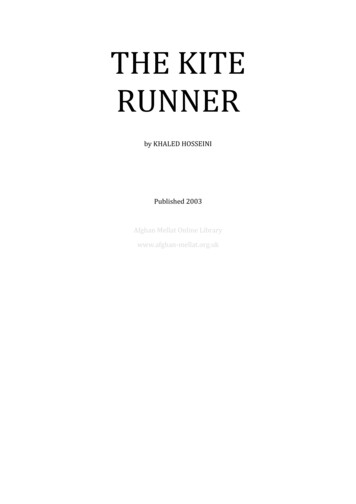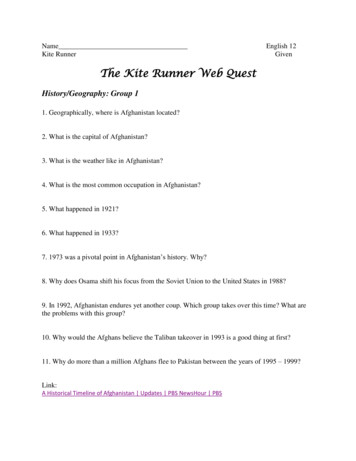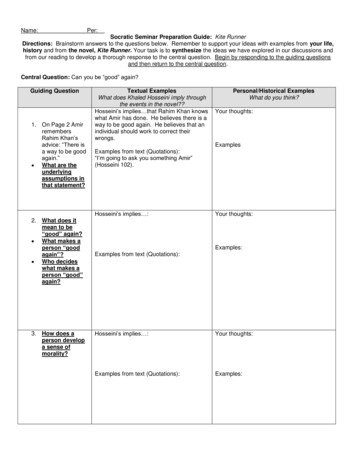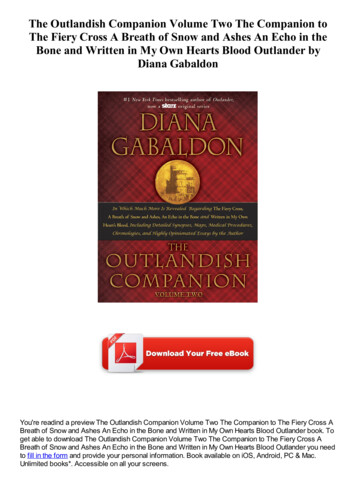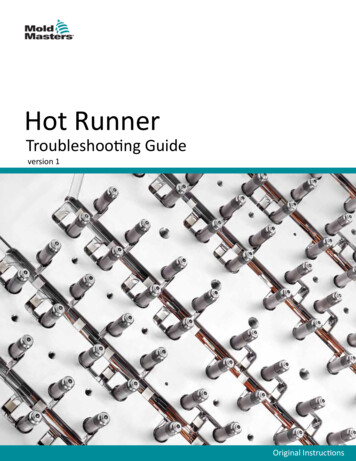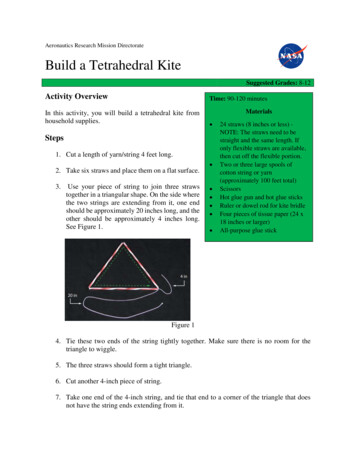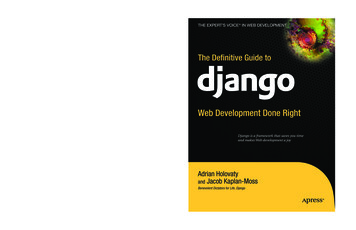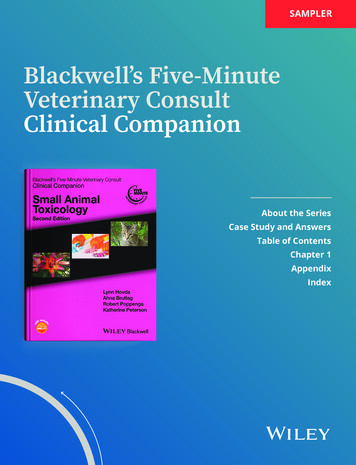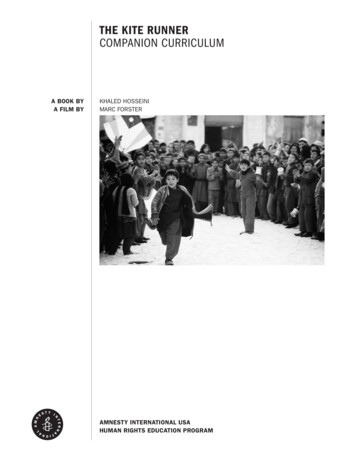
Transcription
The kite runnercompanion curriculuma book bya film bykhaled hosseinimarc forsterAmnesty international usahuman rights education program
acknowledgementsTHE HUMAN RIGHTS EDUCATION PROGRAM AT AMNESTY INTERNATIONAL USAWOULD LIKE TO RECOGNIZE THE FOLLOWING CONTRIBUTORS TO THISCURRICULUM GUIDE. WITHOUT THEIR DEDICATION, HARD WORK AND PERSONALCOMMITMENT TO THE ISSUES THAT EMANATE FROM THE FILM, THIS GUIDEWOULD NOT HAVE BEEN POSSIBLE.Writercontributors SHEETAL KHEMCHANDANI-daswaniSONAM DOLKERCLARE GARVIESAMANTHA LEELUCIA NOYCEPATRICK PHELANMOHAMMED H. QAYOUMISARNATA REYNOLDSKAREN ROBINSONMELISSA ROBINSONDIANA RYANRACHEL STEIN-HOLMESBARBARA VON SALISOUR FRIENDS AT THE AFGHANISTAN RELIEF ORGANIZATIONOUR FRIENDS AT THE INTERNATIONAL RESCUE COMMITTEEOUR FRIENDS AT PARTICIPANT PRODUCTIONSacknowledgements
TABLE OF CONTENTSIntroductionfilm synopsis 4What is Kite-running? 5From the author 6From the Editors 7Movie Discussion Guide 9Lesson 1Introduction to Afghanistan 11Appendix 1 – Handouts & Teacher Resources 14Lesson 2Historical Overview of Afghanistan 20Appendix 2 – Handouts & Teacher Resources 23Lesson 3Challenges Facing Human Rights in Afghanistan 28Appendix 3 – Handouts & Teacher Resources 31Lesson 4The Impact of Fundamentalism 37Appendix 4 – Handouts & Teacher Resources 40Lesson 5Refugees and Resettlement 49Appendix 5 – Handouts & Teacher Resources 53additionalresourcesresourcestrengthening Further Reading 60FEEDBACK FORM 64table of contents
film synopsisfilm synopsisThe Kite Runner chronicles the lives of specifically two boys, Amir and Hassanwithin the politically, socially and culturally charged landscape that is Afghanistan.Hassan, a Hazara, is Amir’s servant, best friend, half-brother and a survivor of anunconscionable discrimination and betrayal. Amir, a Pashtun, is a confused youthwho allows emotions, society and privilege to overshadow what he knows is rightand wrong. The story is a riveting tale that clearly documents the trials and tribulations of adolescents and their friendships, as well as their ever-changing valuesand moral systems especially in the face of ethnic conflict, war and social stigmas.The Kite Runner is one of few films that truly demonstrate both internal conflicts within individuals and countries as well as the external conflicts that affectthem. Afghanistan’s multi-ethnic mosaic of citizens allows for a truly memorabletapestry of storylines about fathers and sons, servants, best friends, love, family,loyalty, betrayal, reconciliation, redemption, war, fundamentalism and discrimination. The film acts as a powerful platform that creates a space to discuss a vastvariety of human rights issues. It creates an opening for awareness, dialogueand social action which are three of the most important goals of AmnestyInternational’s Human Rights Education Program. This surprising story of a youngman’s struggle with his family, country and with his own self is so profound andeverlasting that its effects and lessons will forever remain with the viewer. INTRODUCTION
Film synopsiswhat iskite running?“Hope is knowing that people, like kites, are made to be lifted up.”- Afghanistan Relief OrganizationKite-running (Gudiparan Bazi) has been a favorite pastime in Afghanistan forthe last 100 years, but there are few on the streets of Kabul that can forget theterror of living under the Taliban regime for so many years. Under Taliban rule, ifyou were caught with a kite, many times you would be beaten and the spoolwould be destroyed. However, since the fall of the Taliban regime, kite-runninghas again resurfaced tenfold.Kite-running is a two-person affair, with one person called the “charka gir” andthe other called the “gudiparan baz.” The charka gir is in charge of the holdingthe wooden kite spool, around which the wire, or “tar” is wound. The secondperson, called the “gudiparan baz” actually is in control of the movement of thekite in the air. Kite flyers stand on tops of buildings, fighting with kites from allover the city. The object is to strike down the kite of your opponent with thestring of your kite, after which you will be called the winner. The strings are oftenmade with razor wire which gives the sharpness to cut down other kites. After anopponent’s kite is set free, it flutters away into the wind where it is usually pickedup by the local children, who fly it the next day as their own.Kites are made of either extremely fragile tissue paper, or heavier more durablemylar fabric. They come in many colors, shapes, and sizes. Kites range in pricedepending on the size and materials used to make the kite. For a small, simple,child sized kite, the price starts at just a few cents. For large, elaborate, colorfulkites, many with dangling adornments, the price can cost as much as [2 to 100]Afghanis, or 2 US.(Quoted from “Kites for Kabul: Flying for Freedom”. Available online /index.htm) introduction
from the authorkhaledhosseiniI want to thank the Human Rights Education Program at Amnesty International USAfor this comprehensive guide to The Kite Runner film. I think they have done a terrificservice to the students, and I am grateful to them for bringing to light the nuances andmany complexities of Afghan society and Afghan life via this guide.Even though Afghanistan plays a pivotal role in U.S. foreign policy and so much time,manpower, and money has been invested into making it a functional state, Afghanistan remains largely an enigmatic and misunderstood society to many people in thewest. I still frequently encounter people who believe that Afghans are ethnic Arabs,or that Afghans as a people are anti-west, or that the Taliban accurately represent amajority of the Afghan people. One of the most rewarding aspects of the success ofThe Kite Runner to me has been in dispelling some of these pre-conceived notions,and in seeing that the book has helped spark interest in Afghanistan among readers.One of the most vocal groups of readers has been high school and college students.I have visited many college and high school campuses to discuss the novel and stillregularly receive letters in batches of thirty or more from students who read The KiteRunner in class. I am always impressed by how sophisticated students at that ageare, and by their ability to grasp subtext and context. Many of them write to tell methat The Kite Runner is their favorite book and that they eagerly look forward to seeingthe film. I think this guide is a wonderful way of turning the experience of merelywatching a film into an opportunity to learn about a vastly different culture. As both anauthor and an Afghan, I appreciate the care that the Human Rights Education Programat Amnesty International USA has taken in devising this guide to the film. I am thrilledthat this film will help students understand better issues such as ethnic relations, regionalism, and fundamentalism. Additionally, as an envoy to the UN Refugee Agency,I am very pleased to find within a section on the plights of the Afghan displaced andrefugees.I thank the Human Rights Education Program at Amnesty International USA for usingthe release of The Kite Runner film as an opportunity to build bridges and engagestudents in meaningful discussions about issues that, given the realities of today’sworld, affect us all. You have my deepest thanks.– Khaled Hosseini introduction
from the editorhow to usethe guideThe companion guide for The Kite Runner provides activities and lessons to engagelearners in a discussion of issues which seem difficult and complex, such as ethnicdiversity, gender inequality, and the interplay between upper and lower socioeconomic and political classes in Afghanistan. Designed to be as comprehensive andinformative as possible, this guide can be used in its entirety as an in-depth unit ofstudy or individual lessons can stand alone as learning extensions after watchingthe film. For more tips on using film in educational settings, please go to our website: http://www.amnestyusa.org/education. Additional resources, such as international human rights declarations, fact sheets and links to actions and reports canalso be found on the Amnesty International USA website listed above.Prior to showing the film, educators should prepare learners by having a shortbackground discussion around the main themes of the film. For example, educatorscould review with students a map of Afghanistan that shows all of its ethnic groups.Such a map can be found at nic.html. For background information relating specifically to Pashtuns and Hazaras,educators should visit http://www.afghan-network.net/Ethnic-Groups/. A briefhistorical timeline of Afghanistan can be found at http://news.bbc.co.uk/1/hi/world/south asia/1162108.stm. For any additional research or information and resources,please also visit the websites of the International Rescue Committee at http://www.theIRC.org and Afghan Relief Organization at http://www.AfghanRelief.com.After using this curriculum, please take the time to fill out the feedback form foundat the end of this guide or online at: culumobjectivesThis Curriculum aligns with the following standards outlined by McREL(Mid-continent Research for Education and p Behavioral Studies: Standard 1, Level IV (Grades 9-12) – Understands that groupand cultural influences contribute to human development, identity and behavior Historical Understanding: Standard 2, Level IV (Grades 9-12) – Understandshistorical perspective Language Arts: Standard 7, Level IV (Grades 9-12) – Uses reading skills andstrategies to understand and interpret a variety of informational texts To introduce the ethnic groups of Afghanistan and to understand human rightsissues that arise through ethnic rivalries To explore the history of political influence in Afghanistan and to recognize itsrole in creating channels for human rights abuse introduction
from the editorcompanioncurriculumobjectives(continued) To brainstorm definitions for terms such as regionalism, warlordism andfundamentalism with regard to human rights To understand the plight of refugees and internally displaced peoples andto critically consider the challenges associated with resettlement To engage students in discussion of personal and collective responsibility,with specific emphasis on forgiveness, reconciliation, redemption, socialresponsibility and activismtargetaudience This guide is designed primarily for high school and college students. It can beused in social and international studies classes, history classes, arts and literatureclasses, or as a stand-alone learning opportunity. It can also be used in community settings, such as film festivals, house party screenings, or group meetings.Individual lessons can act either as stand alone lessons or as a part of a wholesemester long series. Most sections of critical thinking questions are divided intotwo parts - general questions, and advanced questions. It is up to the educator todecide which parts are applicable to his/her audience. For community settings orsmall group settings, it may be sufficient to use only the movie discussion guide tospark dialogue and debate.introduction
movie discussion guideDISCUSSIOnQUESTIONSThe following is a comprehensive list of discussion questions. Educators shouldfeel free to use some or all of the questions depending on the audience. It is alsorecommended that learners do an initial read-through of the questions beforeviewing the film.1. What are some of the human rights issues or injustices that are portrayed inthis film?2. What was happening politically in Afghanistan during the film?3. List some of the recurring themes of the film.4. In one of the opening scenes, we see Amir and Hassan returning home from agame of kite-fighting. The boys part ways and Amir walks up his redbrick driveway linedwith trees and rosebushes towards his magnificent house; whereas Hassan walkstowards a little mud hut. In what way does this scene set the stage for this film?5. Could Hassan be considered wealthier than Amir in some ways? Why or why not?Define wealth. What are some criteria we can use to measure one’s personal innerwealth?6. A quote in the first chapter of The Kite Runner book was “Afghans like to say:Life goes on, unmindful or beginning, end crisis or catharsis, moving forward likea slow dusty caravan of kochis (nomads).” How does this idea resonate throughoutthe film?7. How did war, conflict and human rights abuse change the characters of the book?8. Who chose to stay in Afghanistan during the Soviet Invasion? Who chose to flee?Who did not have a choice? Why?9. Did Amir and Baba Jan become internally displaced peoples? Refugees? Orboth? What rights were taken away from them when they had to leave their home?(In-depth study of IDP’s and Refugees can be found in Lesson 5)10. What kind of resettlement process did Baba and Amir have to go through? Whatkind of resettlement process did some of the other characters endure?11. When Amir failed Hassan, would you consider his action a human rights abuse?Why?12. What did Rahim Khan mean when he said to Amir, “there is a way to be goodagain”? Was it important for Amir to redeem himself? Why? Are we always able toreconcile with past mistakes or past human rights abuses? Is it important to do so?Why? introduction
movie discussion guideDISCUSSIOnQUESTIONS(continued)13. How do pride and privilege affect Amir and his actions?14. Baba says to Amir “there is only one sin, only one. And that is theft. Everyother sin is a variation of theft When you kill a man, you steal a life. You stealhis wife’s right to her husband, his children’s right to their father. When you tell alie, you steal someone’s right to the truth There is no act more wretched thanstealing.” Do you agree with Baba? List some other rights that could be violated bystealing that Baba does not mention.15. In the scene where Assef attacks Hassan, what rights did he steal fromHassan?16. Assef says in the film to Amir, “Afghanistan is the land of Pashtuns. We are thetrue Afghans, not this Flat-Nose here. His people pollute our homeland. They dirtyour blood.” How does Assef’s attitude compare to some of the individuals or groupswe have learned about in our history classes? (the KKK, Hitler, etc) Can Assef’sattitude lead to human rights issues, such as hate crimes in our neighborhoods?How?17. Baba says to Amir, “I grew up with Ali. My father took him in, loved him like hisown son. Forty years Ali’s been with my family.” Yet the cycle continues where neitherAli nor Hassan could read or write and both eat Baba’s and Amir’s leftover food. Ina society where individual roles are so defined and ingrained, how can one go aboutchanging them? What responsibility do we have to break these unjust norms? Howcan we?10introduction
lesson 1: introduction to onand materialsWhat are the different ethnic groups in Afghanistan? Which countries surroundAfghanistan? What are some of the important terms used when studying Afghanistan?One 90 minute class or two 45 minute classesAfghanistan has approximately 8 major ethnic groups residing within 34 provincesor mini-states, each having its own distinct cultural and political identity. The 8major ethnic groups are the Pashtuns, Tajiks, Hazaras, Uzbeks, Turkmen, Nuristanis, Aimaqs and Balochis. This lesson will introduce students to the various ethnicgroups of Afghanistan and will also introduce students to important terminologythat will be used in later lessons.Students will be able to: Demonstrate knowledge of the ethnic groups of Afghanistan Garner an understanding of the region through a map exercise Become familiar with some key terms that will be used throughout this curriculumHANDOUT 1.1 – Ethnic Groups of AfghanistanHANDOUT 1.2 – Map ExerciseHANDOUT 1.3A – Words and TermsHANDOUT 1.3B – Definitionsteacher resource #1 – Map Exercise***ALL HANDOUTS CAN BE FOUND IN APPENDIX ONE AT THE END OF THIS LESSON***activity #1(30 minutes)PROCEDUREquiz11THE 8 ETHNIC GROUPS OF AFGHANISTAN1. Distribute Handout 1.1 to students2. Divide students into 8 groups and assign each group one ethnicity3. Allow students 3-5 minutes to become familiar with their newfound ethnicity4. Have each group tell the rest of the class who they are, what they areknown for, and where they reside in Afghanistan5. After this is complete, ask students to put away Handout 1.16. Divide the students into 2 groups, A & B, and engage them in a surprise quiz7. Draw a score sheet on the chalkboard for groups A & B8. Ask students the questions that follow. Whichever group answers firstand correctly should receive 5 points for general questions and 10 pointsfor advanced questions. (the answers are in brackets for Educator use)GENERAL QUESTIONS1. What is the population of Afghanistan? (approximately 32 million)2. How many major ethnic groups are there in Afghanistan? (8)3. What are the official languages of Afghanistan? (Pashtu and Dari)4. What is the major religion in Afghanistan? (Islam)5. Which two ethnic groups are the largest in Afghanistan?(Pashtuns and Tajiks)6. What is the main language of the Pashtuns? (Pashtu)lesson 1
lesson 1:quiz(continued)introduction to afghanistan7. Why are the Pashtuns so influential in Afghanistan?(Large role in government)8. Approximately how many Tajiks are there in Afghanistan? 25-30%?12-17%? 5-10%? (27%)9. Where do most Hazaras reside? (central Afghan mountain region/Hazarajat)10. According to the handout, which ethnic groups were historically best knownfor farming? (Uzbeks and Turkmen)11. Which ethnic groups are best known as nomads or for camel breeding?(Aimaqs)12. In the film, Amir was a and Hassan was a .(Pashtun, Hazara)advanced QUESTIONS1. How many minor languages are spoken in Afghanistan? (approximately 30)2. What sect do the majority of Muslims in Afghanistan belong to?(Sunni Islam)3. What are the Tajiks best known for? (Being agriculturists or townspeople)4. What sect of Muslims do most Hazaras belong to? (Shi’ite Islam)5. Hazaras have origins. (Mongolian)6. BONUS: True or False: Afghanistan is in the Middle East (False, Afghanistanis in Central Asia)7. BONUS: What other religions besides Islam are present in Afghanistan?(Zoroastrianism, Buddhism, Hinduism and Sufism)Activity two(15-20 minutes)PROCEDURE12WHERE IS AFGHANISTAN? (MAP EXERCISE)1. Distribute Handout 1.2 to students2. Ask students to find the following on the map. Give them about30 seconds to write each place onto their map Afghanistan Pakistan India China Russia The Arabian Sea Iran Tajikistan Kyrgyzstan Turkmenistan Uzbekistan Azerbaijan Kazakhstan Bonus: Where is Peshawar? Why is Peshawar significant whenstudying Afghanistan?3. Collect maps from students, mark corrections and return them next class4. Now ask students to write down the names and capitals of eachlesson 1
lesson 1:introduction to afghanistancountry they were asked to find. Capitals are: Afghanistan-Kabul,Pakistan-Islamabad, India-New Delhi, China-Beijing, Russia-Moscow,Iran-Tehran, Tajikistan-Dushanbe, Kyrgyzstan-Bishkek, Turkmenistan Ashgabat, Uzbekistan-Tashkent, Azerbaijan-Baku, Kazakhstan-Astana5. Have students memorize capitals overnight and quiz them a fewclasses laterActivity three(30-40 minutes)PROCEDURElesson one13IMPORTANT TERMINOLOGY RELATING TO AFGHANISTAN (VOCABULARY EXERCISE)1. Distribute Handout 1.3A to students2. Ask students to work in groups to brainstorm what the words orterms could mean. Some terms should be familiar from History andSocial Studies classes3. Now Distribute Handout 1.3B to students4. Have students compare what they wrote, to what is written onHandout 1.3B5. Have each group explain the meaning of one word or term to the restof the class6. Allow students time to interact with each other especially if they areconfused or unclear. Give learners about 4 or 5 minutes to figure out eachdefinition of each word or term amongst themselves before helpingthem out7. Have students study these terms for homework as they will pop up in thefollowing lessonscompletedlesson 1
handout 1.1Ethnic Groupsof Afghanistanpashtunstajikshazaras14introduction to afghanistanAfghanistan is an ethnically diverse country. Its inhabitants form a complex mosaic ofethnic and linguistic groups, a reflection of the country’s geographic location as wellas its history of frequent external occupiers. As of July 2007, there are approximately32 million people estimated to live in Afghanistan. Pashtu and Dari are consideredthe official languages of Afghanistan, and are spoken by 85% of the people. Thirtyother minor languages are also spoken in Afghanistan, representing the last 4% ofthe population. There is also a large degree of bilingualism amongst the inhabitantsof the country. About 99% of the population is Muslim, and of these Muslims, 84%belong to the Sunni sect. There has been a long history of an ethnic hierarchy withinAfghanistan. It has created imbalances in wealth, influence and education within itssociety. Traditionally, Pashtuns have dominated the country because they are thepresumed majority of the population. As a result, many of the other ethnic groupshave not had a strong voice within the society. The ethnic groups in Afghanistan donot form a concrete caste system like India. But, the society does have a firm andstructured hierarchy which dominates the inter-ethnic interactions and relations. Pashtuns are the majority ethnic group in Afghanistan, about 42% therebyconstituting just under half of the population They are the highest ethnicity on the social ladder and dominate governmentalbodies Pashtu is their native language They consist mainly of Sunni Muslims Tajiks account for about 27% of the population of Afghanistan They are the second largest ethnic community within Afghanistan They are identified with agriculture and town life They mainly inhabit the fertile eastern valleys They are a group that is considered to have low income and like many Hazaras,they are not the highest on the social ladder. However, there Tajiks that aresuccessful and important members of the government Large numbers of Tajiks are city dwellers as well The Hazara ethnic group resides mainly in the central Afghanistan mountainregion called ‘Hazarajat’ They make up approximately 9% of Afghanistan’s population There are also significant populations of Hazaras in Pakistan and Iran Historically, the Hazara seem to have Mongolian origins, as evidenced by physicalattributes and parts of the culture and language It is commonly believed that the Hazara are descendants of Genghis Khan’sarmy, which marched into the area during the 12th century. Proponents of thisview hold that many of the Mongol soldiers and their family members settledin the area and remained there after the Mongol empire dissolved in the13th century, converting to Islam and adopting local customsappendix 1
handout 1.1 cont.hazaras(continued)uzbek andturkmennuristanis,aimaqs andbaluchisintroduction to afghanistan Most of the Hazaras are Shi’ite Muslims, and, the 1% of the population which is notMuslim is either Hindu, Sikh, or Jewish In The Kite Runner book and movie, it is evident that Hazaras are considered to beon the lower end of the socio-economic scale 12% of the population is comprised of the Turkmen (3%) and Uzbeks (9%) The Uzbeks are descendants from the Turkish invasion around the beginning ofthe first millennium The Turkmen are related to the Uzbeks and are mostly farmers, herders andcraftsmen and live in the northern plains These two groups are such a small part of the population that they have notbeen able to hold many positions of power. The remaining 10% of the Afghan population is comprised of the Nuristans,an ancient people of Mediterranean descent, the Fariswan, the ethnic Shi’a Persians,the relatively few in number Baluchis of the south, and the scattered members ofthe Kuchi and Aimaq nomads Nuristanis are predominantly Sunni who speak dialects of Dari and often also Pashtuo They live in the Kunar, Nangarhar, Laghman, and Parwan areas of easternAfghanistano The area where the Nuristanis live, Nuristan, was the scene of the first armedopposition to the Khalq government Aimaqs are more of farming and herding tribe rather than an ethnicityo They inhabit the western part of Afghanistano They speak Dari and are predominantly Sunni Muslims The Balochis comprise approximately 2% of the populationo They are a Sunni Muslim group with Iranian ties and they live mostly insouthern Afghanistano They have historically been a nomadic tribe and were well known forcamel breedingo They also speak Dari and Pashtu as well as their own, Baluchi. These tribes areall extreme minoritiesThe information on this fact sheet has been sourced from the following org/newshour/indepth www.afghan-network.net/Ethnic-Groups/15appendix 1
handout 1.2introduction to afghanistanmap exercise16appendix 1
handout 1.3AWORD OR al RivalriesGuerilla WarfareMini-StatesCentral ic ReconstructionEthnic HarmonyNational IntegrationNation State17appendix 1introduction to afghanistanPOSSIBLE DEFINITION
handout 1.3BWORD OR TERMPOSSIBLE DEFINITIONSovereigntyA state is considered a sovereign state when its government possessesfull control over its own affairs within its geographical bordersInfluencerAny country or organization that can shape the dynamic of a country– whether political, economic or militaryOccupierA country that forcefully invades and occupies another nation’s territoryNarco-StateA country that relies heavily on the sale of narcotics for the progress of itseconomy. A state can also be called a narco-state when it is controlled andcorrupted by drug cartels and when law enforcement is extremely ineffectiveImperial RivalriesWhen stronger countries fight for control or influence over another countryGuerilla WarfareWhen small groups of combatants engage in surprise tacticssuch as ambushes and raids against a country’s leading army in orderto take control over the armyMini-StatesMini-states within one nation state arise when there are several differentethnicities living in different regions of a country- And where each ethnicity ineach region has a different political, social and economic cultureCentral GovernmentThe central government in a country is the supreme governmental authorityof a country which sometimes delegates authority to regions or mini-statesWarlordsA warlord is one who exercises military power in a region of a countrythat the central government cannot effectively controlFundamentalistsThose who advocate the replacement of secular law with religious lawin accordance to literal translations of sacred texts such as theBible or the Qur’anRegionalismRegionalism arises when every mini-state or province in a countryhas its own political, economic and social culture and is governed by localregional leaders rather than the central government. Regionalism occurswhen the central government cannot provide adequately for eachof its mini-states or provincesEconomic ReconstructionThe rebuilding of a nation’s economic, social and political infrastructureafter it has gone through a serious depressionEthnic HarmonyWhen ethnicities in all mini-states of a country can live togetherin peace without rivalryNational IntegrationWhen the central government makes economic, social and politicalefforts to unify all ethnic groups within the country’s bordersNation State1introduction to afghanistanThe state is a political and geopolitical entity; the nation is a culturaland/or ethnic entity. The term “nation-state” implies that they geographicallycoincide, and this distinguishes the nation-state from the other typesof state, which historically preceded it.1Anderson, Benedict (1991) Imagined Communities, Reflections on the Origin and Spread of Nationalism. Revised Edition ed. London and New York: Verso18appendix 1
teacher resource 1introduction to afghanistanmap exercise(answers)19appendix 1
lesson 2: historical overview of afghanistanQUESTIONStimeoverviewHow has the political dynamic of Afghanistan, both historically and currently, createdan opening for human rights injustices to take place?One 45 minute classAfghanistan is a country that has a history of being politically unstable. There areseveral states within a state, the lack of a strong central government has given riseto regionalism, warlordism and fundamentalism. As we saw through the depictionof the Russian invasion in The Kite Runner, there have also been multiple externalfactors and actions that have led to the country’s current state. For the last few centuries at least, Afghanistan has been a buffer zone as well as a zone of contentionfor a variety of foreign influencers. This lesson will give an overview of the politicaldynamic in Afghanistan, both past and present.objectivesStudents will be able to: Explore the historic and current political landscape of Afghanistan Brainstorm the human rights connection to the country’s political statepreparationand materialsHANDOUT 2.1: THE HISTORY OF POLITICAL INFLUENCE IN AFGHANISTANHANDOUT 2.2: TIMELINE: AFGHANISTAN***ALL HANDOUTS CAN BE FOUND IN APPENDIX TWO AT THE END OF THIS LESSON***activity one(30-40 minutes)procedure20UNDERSTANDING THE LEGACY OF EXTERNAL INFLUENCE IN AFGHANISTANHandout 2.1 is a chart that details every major influenc
The Kite Runner is one of few films that truly demonstrate both internal con-flicts within individuals and countries as well as the external conflicts that affect them. afghanistan’s multi-ethnic mosaic of citizens allows for a truly memorable tapestry of storylines about fa

